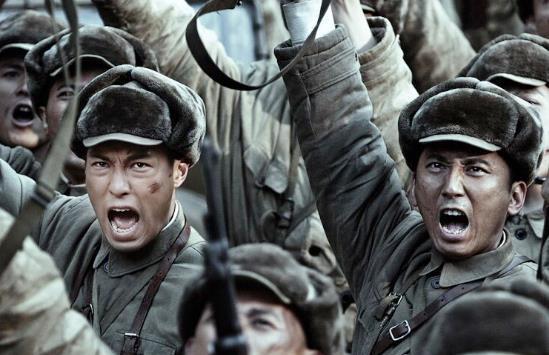On November 1, 1950, the 39th Volunteer Army launched an attack on the 8th Regiment of the U.S. 1st Cavalry Division, which was besieged at Yunshan.
The U.S. First Cavalry Division, known as the Ace Army of the United States, was formed at the founding of Washington, and was formerly a cavalry, now changed to the Army, but the number has not changed at all.
Although the unit had no horses, it was replaced by armored vehicles and tanks, but the soldiers still had horse head insignia on their armbands, which was a symbol of their glory and glory - in the 100-year history of the first cavalry division, they had never been defeated.
When the Volunteer Thirty-ninth Army suddenly appeared in front of the Americans from a hidden predetermined attack site, they still relied on superior weapons, did not mess with the measure, and resisted step by step.

The Thirty-ninth Army was the former 2nd Column of the Northeast Field Army, with the 115th, 116th, and 117th Divisions under its jurisdiction, and was also the ace unit of The Eastern Field. The predecessors of this unit were the Red Fifteenth Army, the 344th Brigade of the Eighth Route Army, and the 3rd Division of the New Fourth Army.
After marching into the northeast, it was formed as the second column on the basis of the Third Division of the New Fourth Army, with the first column commander Liu Zhen and the political commissar Wu Faxian (later succeeded by Wu Xinquan).
This unit was the main force in the Siye Army in both the Liaoshen Campaign and the Pingjin Campaign, and on the eve of entering the Dynasty, the commander Liu Zhen was ordered to form the Chinese Air Force, and Wu Xinquan succeeded him as commander.
After entering the DPRK, Wu Xinquan knew very well that the glorious military achievements of the Thirty-ninth Army had become a thing of the past, and more arduous battles were coming, and in order to maintain the fine traditions of the Thirty-ninth Army, he never dared to take it lightly.
Yunshan is not actually a mountain, but a small city shrouded in white fog, but surrounded by rolling mountains.
After the battle officially began, the 116th Division of the 39th Army of the Volunteer Army took the lead in launching an attack on the enemy's front, and the soldiers were highly motivated, quickly crossing the trench and braved the dense artillery fire.
Among the various offensive units of the Volunteer Army, the four companies of the second battalion of the 346th Regiment fought the most courageously and resolutely. They plunged straight from the enemy gap into the enemy's deep mountain and burst into Yunshan Street in one fell swoop.
When they reached the highway bridge, the U.S. troops guarding the bridge regarded them as South Korean troops and obediently gave them a way to open a road.
The commanders and fighters of the fourth company fought extremely bravely and very witly, and they calmly faced the US army, and they even swung through the bridge guarded by the US army and raided the command post of the us third battalion in a posture of directly smashing the yellow dragon.
Faced with this sudden blow from the volunteer generals, the unsuspecting American troops were beaten to death and fell into a state of chaos.
Subsequently, the two armies engaged each other and entered the street battle that the American army was very afraid of. At this time, the follow-up troops of the volunteer army continued to attack, and for a time there were shouts and gunshots.
Since the officers and men of the US army embarked on the battlefield of invasion of Korea, they had never faced such a sudden and rapid attack. Although they were tall and tall, they were extremely uncomfortable with the white-knife fighting at close range, and the more they fought, the more frightened they became, and they could not stop the fierce offensive of the volunteer army.
U.S. Army commander MacArthur was shocked to learn that Yun Shan was in a hurry. In order to rescue the Eighth Cavalry Regiment, which was becoming more and more chaotic, he urgently transferred the Fifth Regiment from Bochuan to Yunshan for reinforcements, but was stubbornly blocked by the soldiers of the 3rd, 43rd Regiment, a volunteer reinforcement.
Relying on sophisticated weapons and equipment, the enemy army launched a fierce attack in turn with aircraft, heavy artillery, incendiary bombs, and tanks, and continuously carried out indiscriminate bombardment, and the volunteer positions were filled with smoke and dust, and the fighting was extremely fierce and cruel.
However, after two days and two nights of frenzied attacks, the Americans were never able to advance, and their Fifth Cavalry Regiment Commander was also killed in the battle.
On November 3, the U.S. army in Yunshan dispatched a large number of aircraft and tanks to break through, but it was still unable to succeed and fell into despair. By that night, they were finally completely annihilated by the volunteers, which was known as the Battle of Yunshan.
Intriguingly, the campaign also won wide acclaim for the Volunteers internationally.
The Japanese Ground Self-Defense Force Cadre School (in fact, the Japanese Military School), which aims to train middle and senior officers, compiled a "Primer on Combat Theory" as a military textbook, and the case of the Battle of Unzan was included in the book. The Japanese side believed that the tactics of the Thirty-ninth Army of the Volunteer Army were very reasonable in this campaign and achieved a successful victory.
In fact, the Battle of Yunshan was also the first confrontation between the Chinese and American armies in modern history, and the United States admitted: "The first disastrous encounter between the American army and the communist army led to the complete withdrawal of the Eighth Army." ”